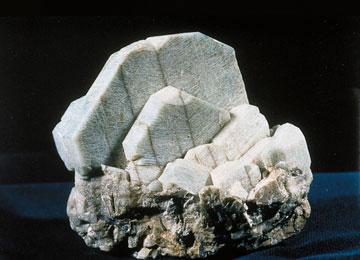Microcline
Microcline is a variety of feldspar. It is rich in potassium, with the chemical formula KAlSi3O8 - but also contains small amounts of sodium (replacing some of the potassium ions). Microcline can occur in several colors, including clear, white, pale yellow, pink, green or red. Although common, microcline is not particularly well known.[1]

Microcline - 6.4cm long
Photo by Rob Lavinsky, iRocks.com - image lic. under CC-BY-SA-3.0
Microcline also includes the sub-categories amazonite, a green / blue variety, and perthite - a veined / somewhat "zebra-striped" variety. [2] These two stones are sometimes fashioned into decorative objects, tumbled stones or cabochons. Occasionally, these types of microcline may be seen as faceted gems, and I have seen one picture of a transparent amazonite - but these are uncommon. [3]
Microcline has a hardness of 6-6.5 (Mohs). It is polymorphous with the other potassium feldspars - orthoclase and sandinine. This means that they have the same chemical formula, but a different crystalline structure and hence different shape. Microcline is triclinic, whereas Sandinine and Orthoclase are monoclinic [4] - and the name "microcline" comes from the Greek for "small slope", which refers to the crystal's prism angle. [1]
Microcline History
The noted Geman mineralogist Johann Friedrich August Breithaupt (1791-1873) is accredited with being the first to identify microcline, in 1830. [5] Breithaupt is credited with the discovery of 47 mineral species. [6]
Microcline forms some of the biggest crystals known anywhere - including one believed to be 17,000 tons found in Colorado. [7]
Microcline's distribution is widespread, with notable sources in Australia, Brazil, Canada, China, Norway, Russia, Sweden, the USA and many other places. It has been found in association with many gemstones, including muscovite, quartz, biotite, smoky quartz, aquamarine, magnetite, spessartine, fluorite, topaz, tourmaline, lepidolite and hornblende. [8] [9]
Another variety of microcline is ferruginous microcline, an iron rich variety, which is colored red, pink-red or red-brown. [8] Microcline is also found in small amounts in the semi-precious stone charoite.

Microcline
Microcline - Sources Referenced:
[1] http://en.wikipedia.org/wiki/Microcline
[2] http://www.galleries.com/minerals/silicate/microcli/microcli.htm
[3] http://www.realgems.org/list_of_gemstones/feldspar.html
[4] http://www.minerals.net/mineral/silicate/tecto/feldspar/microcln.htm
[5] http://books.google.com/books?id=KgE5AAAAMAAJ&pg=PA442
[6] http://en.wikipedia.org/wiki/August_Breithaupt
[7] http://www.minsocam.org/ammin/AM66/AM66_885.pdf
[8] http://www.mindat.org/min-2704.html
[9] http://commons.wikimedia.org/w/index.php?title=Special%3ASearch&search=microcline
Back to the Gemstones List home page - over 160 gemstones explored!
Please feel free to link to this page - copy / paste the text below: (click to select)
Privacy Policy | Cookie Policy | GDPR | About This Site / Terms

© gemstoneslist.com


